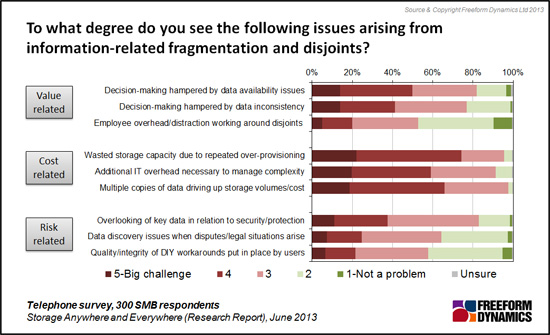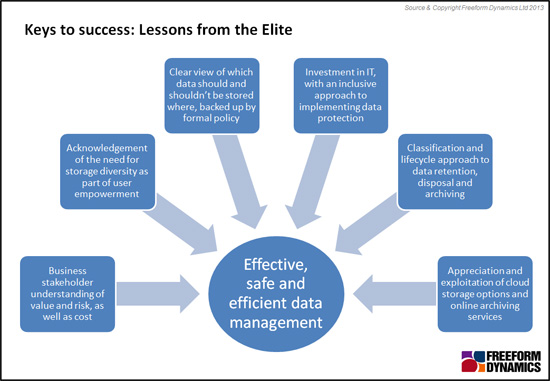By Tony Lock
A recent survey by Freeform Dynamics confirmed that access to accurate information is widely recognised as very important to businesses, especially in terms of exploiting data rapidly as part of operational decision making. In order to make decisions as quickly as possible, many organisations are seeking to “empower” staff by giving them responsibility to make changes with less upwards referral through the management chain. This poses data management challenges CIOs need to address.
The empowerment of users requires them to be able to access the business data they require, when they need it. In addition, it is now common for empowered uses to expect to be able to access, and manipulate, from an increasing number of devices, typically any of a number of Smart-phones, Tablets or home computer systems.
This means that company data is now held across a wide portfolio of computer systems and storage devices. To this is frequently added the challenge that some, if not many, of these devices may be the property of the user rather than being a system procured and managed by the IT department. Data fragmentation is then compounded by information being put into consumer focussed ‘Public Cloud’ services, many of which were not built to handle sensitive corporate data.
The survey revealed that this ‘data fragmentation’ often results in significant pain points that CIOs are being asked to handle (Figure 1). Broadly speaking the issues identified fall into three main categories, namely risk related challenges, the generation of value from corporate data and the non-trivial matter of steadily climbing storage costs.

Figure 1
The risk and security concerns of data stored on different devices and cloud services are widely recognised, but overall it was seen to be a significant challenge by the smallest number of respondents. Slightly higher numbers reported that decision making difficulties and staff distraction concerning data access and management were of concern. It is the issue of the cost of storing data and its long term management that was identified by the largest proportion of respondents to be challenging.
This leaves CIOs facing the question of how can they best tackle data fragmentation? The report identified a small group of ‘elite’ performers whose experience can be mined.
Call to action
Careful analysis of the survey results highlighted an ‘elite’ group of respondents who are most effective at managing, securing and exploiting corporate information. The group is also more confident of its abilities to do so in the immediate future than others taking part in the survey. Detailed analysis of the responses of the elite group identified a number of best practices to minimise the cost and risks of storage, many of which CIOs should be able exploit (Figure 2).

Figure 2
The launch point for CIOs is likely to be a data discovery process to locate where different ‘categories’ of data are actually being stored. This step sounds simple, indeed modern storage and asset management solutions offer good capabilities, but given the diverse range of data the organisation holds, it’s best to start with data sets deemed to be of importance rather than trying to discover all data at once.
The next step is to put in place policies covering where different categories of business information can be held, be they on central systems, home PCs, Smartphones, tablets or external cloud services. Depending on the nature of the data the policy may also need to cover any security requirements associated with data stored in different environments. For example it may be decided that any corporate data held on a personal tablet, home PC or in a cloud service must be encrypted using keys supplied and administered internally by the company.
To ensure that the policies meet the needs of the organisation it is essential that line of business managers be involved in policy authoring. Further best practice identified by the elite group is to make sure that users, especially senior managers and executives, understand not only the policies themselves but also recognise why they have been put in place.
The data discovery and classification process may well highlight the potential to rationalise and consolidate the storage infrastructure and enhance security and data protection. The business case for consolidation activities may be relatively straight forwards. Other projects may have the need for business stakeholders to understand the potential business value generation possible with better data management and governance. In certain cases this could be accompanied with an explanation of the advantages of securing sensitive data.
Nearly everyone in the business is aware, at least to some degree, of the frustration data fragmentation causes in daily business activities. It is also clear that growing members of organisations see advantages in better data management as well as recognising the growing costs and risks associated with data fragmentation. By tackling data fragmentation now, CIOs can help the business and potentially save money. Are you ready to get to grips with the challenges?
CLICK HERE TO VIEW ORIGINAL PUBLISHED ON

Tony is an IT operations guru. As an ex-IT manager with an insatiable thirst for knowledge, his extensive vendor briefing agenda makes him one of the most well informed analysts in the industry, particularly on the diversity of solutions and approaches available to tackle key operational requirements. If you are a vendor talking about a new offering, be very careful about describing it to Tony as ‘unique’, because if it isn’t, he’ll probably know.





Have You Read This?
From Barcode Scanning to Smart Data Capture
Beyond the Barcode: Smart Data Capture
The Evolving Role of Converged Infrastructure in Modern IT
Evaluating the Potential of Hyper-Converged Storage
Kubernetes as an enterprise multi-cloud enabler
A CX perspective on the Contact Centre
Automation of SAP Master Data Management
Tackling the software skills crunch